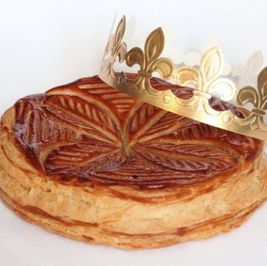A cake. A hidden prize. A paper crown ... Three tantalizing ingredients that officially mark the end of the holiday season in France with La Fête des Rois—Festival of the Kings.
Like most ancient traditions, Epiphany has its roots buried deep in pagan times. Just after the winter solstice and into early January, the ancient Romans paid homage to the god of agriculture, Saturn, with an exuberant festival—Saturnalia. It was a time to visit friends and bring them gifts; candles were a favorite and likely symbolized the return of sunlight. Strict laws were cast aside, gambling was allowed in public, and slaves, who were not required to work, would often enjoy a role reversal where their masters served them. In many households, one slave was chosen to be “King of the Day”—an honor determined by a little bean (la feve) hidden in a special cake called la Galette. After the cake was cut into as many slices as there were slaves, the youngest family member “assigned” each piece to a particular slave. Whoever found the bean in their slice was designated King and could order the family members about for the rest of the day. In the Middle Ages, during the season of collecting feudal fees, it was customary for the slaves to present a cake to their lords. Apparently even Louis XIV celebrated the season with a special Galette at his table at the end of December. The cake nearly disappeared from history in 1711, when a wide-scale famine prompted a prohibition on flour for any use other than bread. Outside of Paris, though, villagers found a way to continue the tradition clandestinely. The French Revolution, too, nearly “took the cake,” as it were ... Properties owned by the Catholic Church were claimed by the new French state, and all Christian holidays were abolished. The celebration of “royalty” was, of course, deemed inappropriate and la Galette des Rois morphed into la Galette de l’Egalité (the cake of equality). The Fete des Rois became la Fete des Sans-Culottes (literally, “those without underwear,” symbolizing the revolutionaries from the lower class). In 1801, the Concordat—an agreement between Napoleon and Pope Pius VII—restored the Catholic Church as the majority religion of France and the Gregorian calendar returned, all holy days accounted for—including Epiphany, on January 6. We French are proud to be able to claim that la Galette survived the fall of the Roman Empire, the ravages of the Middle Ages, and the political upheavals of the French Revolution! Today, most French families celebrate Epiphany—La Fete des Rois—on January 6, or the first Sunday in the New Year. The Galette is still the centerpiece, though the lowly bean has been replaced with a small ceramic prize (still called la feve), that often becomes a treasured possession through the years. The youngest child hides under the table and announces which family member is to get which piece of cake; and whoever “pulls” the lucky slice gets a paper crown and chooses his or her king or queen for the day. There are several versions of Galette, depending on which region of France you come from. Some are brioche-like in consistency, some are made of puff pastry, some filled with marzipan, and some festooned with candied fruits. See my favorite recipe above. Those of you who enjoy all things French may want to close the holiday season with this festive celebration the whole family can enjoy together. It just takes a cake, a hidden prize, and a paper crown. We’re very proud of our Galette des Rois tradition—and especially pleased that no good pastry was ever sacrificed to the making of history! Bonne Année! Comments are closed.
|
|
||||||
